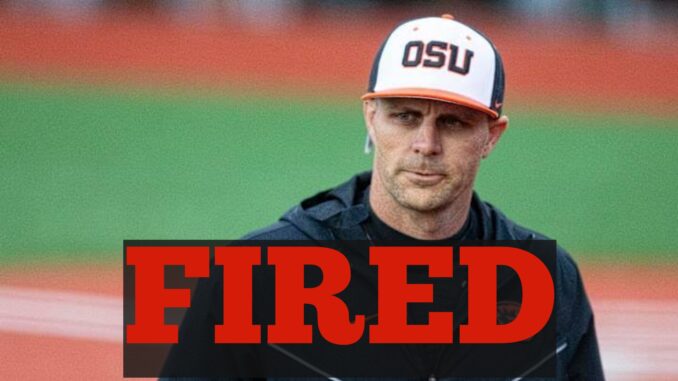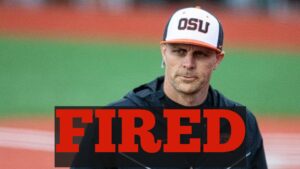
BREAKING: Oregon State Beavers Fire Head Coach Mitch Canham — Five Reasons Behind the Stunning Decision Amid Conference Interview Success
The Oregon State University baseball program sent shockwaves through the college sports world Tuesday afternoon, officially announcing that head coach Mitch Canham has been relieved of his duties. The move comes despite the Beavers’ relatively successful run in the Pac-12 Conference Interview Series and leaves many fans, alumni, and analysts stunned. For a coach who once embodied the spirit and future of Oregon State baseball, the sudden exit marks a dramatic twist in a journey filled with both promise and pressure.
In a somber press conference held at Gill Coliseum, Oregon State Athletic Director Scott Barnes stated, “We are grateful to Mitch Canham for his years of dedication to the Beavers program, both as a player and coach. However, after a thorough evaluation of the direction and trajectory of our team, we have decided that a change in leadership is necessary.”
While Barnes declined to go into excessive detail, sources close to the university and athletic department have revealed five key reasons that led to Canham’s departure, even as the team reached the later stages of the highly competitive Conference Interview run. This article unpacks those five reasons and explores the implications for Oregon State baseball going forward.
1. Declining Postseason Performance Despite Talent
Perhaps the most glaring concern in Canham’s coaching tenure was Oregon State’s underwhelming performance in the NCAA postseason in recent years. Despite consistently boasting highly ranked recruiting classes and a wealth of individual talent, the Beavers were repeatedly eliminated early in regional or super-regional rounds of the NCAA Tournament.

This year, Oregon State entered the postseason with a promising squad, loaded with draft-worthy arms and a potent offense. But once again, they fell short of reaching the College World Series in Omaha — a standard that had been set during the Pat Casey era. It marked the third consecutive season the Beavers failed to advance past the super regionals.
“Talent has not been the issue,” one source inside the program shared. “The players believe in themselves. But there’s been a feeling that we were being out-coached at critical moments, especially in late-game scenarios.
2. Coaching Style and Locker Room Disconnect
Another factor in Canham’s dismissal stems from what insiders describe as a growing disconnect between the coaching staff and the players. While Canham brought passion and energy to the role, several current and former players reportedly raised concerns over his communication style, training regimens, and in-game management.
This friction reportedly came to a head during the final weeks of the season, with internal disagreements over pitching rotations and lineup adjustments during the Conference Interview stretch.
“There was a sense of rigidity,” said a former assistant coach who spoke anonymously. “Mitch stuck to his methods, but the game has evolved. Adaptability is key. Unfortunately, that became a point of frustration inside the clubhouse.
3. Recruiting Plateau and Retention Issues
While Canham initially hit the ground running on the recruiting trail, securing several high-profile high school prospects in his first three years, recent classes have seen a notable decline in star power — especially compared to Pac-12 rivals like UCLA, Stanford, and Arizona.
Compounding the issue is the loss of key recruits and transfers to other programs, including several players who flipped commitments or entered the NCAA transfer portal in search of what they considered “a more player-friendly environment.” While NIL dynamics and national competition have changed recruiting for all programs, OSU’s decline was sharper than expected.
“We lost three top-20 infielders in the last 24 months. That’s not sustainable if you want to be a national contender,” said a recruiting analyst familiar with the program.
4. External Pressure from Alumni and Boosters
Oregon State baseball is more than a collegiate team — it’s a point of pride for the university and the Corvallis community. With three national championships (2006, 2007, and 2018), the Beavers built a winning tradition that alumni and boosters deeply care about.
Over the past two seasons, discontent grew louder from former players, influential donors, and fan circles who felt the program had lost its identity. While Canham was once seen as the perfect bridge between the Casey era and the modern game, his inability to deliver on expectations began eroding trust.
The final straw may have come during the offseason donor meetings, where a group of prominent boosters reportedly threatened to pull funding unless major changes were made within the coaching staff.
“There’s always a breaking point in college athletics, and when alumni believe the standard is slipping, the university has to listen,” one insider shared. “The pressure was mounting.
5. Vision Conflict with University Administration
Perhaps the most overlooked, but pivotal, reason behind Canham’s departure involved a philosophical conflict between the coach and OSU’s top administrators regarding the future of the program.
Reports indicate that Canham pushed for significant facility upgrades, expanded recruiting budgets, and more aggressive NIL strategies. While the administration acknowledged these areas needed attention, there were disagreements about timelines, fiscal feasibility, and compliance.
“The administration wants sustainability. Mitch wanted acceleration,” one university source said. “They couldn’t get on the same page, and that fractured the long-term plan.
The Conference Interview Run: A Final Flicker of Hope
Ironically, Canham’s final run through the Pac-12 Conference Interview Series gave many a glimmer of hope. The Beavers played inspired baseball, knocking off top-seeded USC and outlasting Arizona in a dramatic extra-innings thriller. Canham appeared passionate and reenergized on the sidelines, even stating in postgame interviews that he “believed this group could make a statement in Omaha.”
Unfortunately, the postseason flame fizzled just short of the College World Series berth, and whatever goodwill the Conference Interview run generated wasn’t enough to erase long-term concerns within the athletic department.
Canham’s Legacy at OSU: A Complicated Goodbye
Mitch Canham’s legacy at Oregon State will be complex. As a player, he helped lead the Beavers to back-to-back national titles in 2006 and 2007. As a coach, he maintained a winning record, groomed future MLB talent, and held the program together through a pandemic and changing NCAA landscape.
But the expectations at Oregon State are no longer just about winning games — they are about competing for national championships.
In a short farewell message posted to social media Tuesday night, Canham wrote:
> “I will forever love Oregon State. This university gave me everything — as a student-athlete and as a man. Though my time as head coach has ended, my heart will always be with the Beaver family. Thank you to every player, coach, and fan who supported this journey.
What’s Next for Oregon State Baseball?
The Beavers will begin a nationwide search for their next head coach immediately. Early speculation includes names like:
A top MLB minor league manager with college experience
Assistant coach Ryan Gipson is expected to serve as interim head coach until a permanent hire is made.
One thing is certain: Oregon State still commands national respect, still boasts elite facilities, and still has the resources to attract a top-tier candidate. But with Canham’s departure, the program enters an era of uncertainty — and an urgent need to restore its championship pedigree.
Leave a Reply